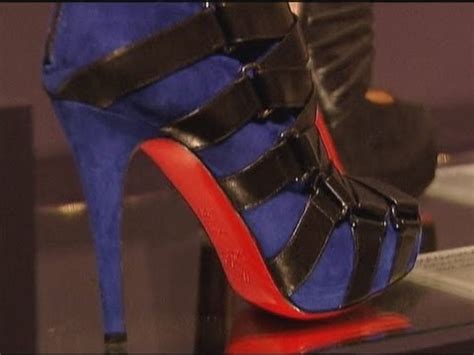ysl vs louboutin | louboutin vs ysl trademark ysl vs louboutin Unhappy with the competitor’s use of a “red sole,” Louboutin filed suit against YSL in United States District Court for the Southern District of New York and sought a preliminary . A modified droop control technique is introduced to facilitate the microgrid performance during both modes of operation. The active and reactive power sharing of the load demand between the utility grid and the microgrid can be performed by this droop control technique during the islanded mode.
0 · louboutin ysl lawsuit
1 · louboutin vs ysl trademark
2 · louboutin court case
3 · louboutin and ysl
4 · christian louboutin ysl
5 · christian louboutin red sole
6 · christian louboutin court case
7 · christian louboutin
Does Insurance Cover You For Driving After a C-Section? Generally, insurance providers do not require notification or impose specific restrictions for driving after a C-section. However, reviewing your policy or contacting your insurance company directly is advisable to ensure you know any particular requirements or limitations.

louboutin ysl lawsuit
Christian Louboutin's request for an injunction to stop sales of red-soled shoes made by Yves Saint Laurent has been denied by the judge considering the case. Judge Victor . Unhappy with the competitor’s use of a “red sole,” Louboutin filed suit against YSL in United States District Court for the Southern District of New York and sought a preliminary . Christian Louboutin's request for an injunction to stop sales of red-soled shoes made by Yves Saint Laurent has been denied by the judge considering the case. Judge Victor Marrero said Louboutin wasn't able to prove that its red soles deserve trademark pr. Unhappy with the competitor’s use of a “red sole,” Louboutin filed suit against YSL in United States District Court for the Southern District of New York and sought a preliminary injunction.
Christian Louboutin, a fashion designer best known for his use of red lacquer on the outsole of the shoes he designs, appealed the district court's order denying a motion for preliminary injunction against alleged trademark infringement by Yves Saint Laurent (YSL). In April 2011, Yves Saint Laurent (YSL) introduced a line of monochromatic red shoes featuring red soles. Louboutin saw this as a direct infringement of its trademark rights and sought a preliminary injunction to prevent YSL from selling these shoes. Christian Louboutin and Yves Saint Laurent will be leaving their 18-month legal battle in 2012, as the Manhattan federal district court officially dismissed the case yesterday, confirming that.
Louboutin asserted that YSL was liable under the Lanham Act for claims including trademark infringement and counterfeiting, false designation of origin, unfair competition, and trademark dilution, in connection with Louboutin’s federal registration for the Red Sole Trademark. In the last 24 hours both Yves Saint Laurent and Christian Louboutin have declared themselves the victor in their on-going court battle over whether a colour can be trademarked. A Christian Louboutin shoe (left) & an Yves Saint Laurent shoe (right) That battle, which played out in federal court in New York – and on the pages of media outlets across the globe – inched towards a close two years later. In the initial suit, Louboutin alleged YSL violated its 2008 red-sole trademark by selling an all-red pump. Presiding federal court Judge Victor Marrero disagreed, denying Louboutin’s request.
NEW YORK — Fashion’s battle over red has ended with a white flag. After a highly publicized legal tug of war that lasted a year and a half, Yves Saint Laurent SA said Tuesday that it will drop. Christian Louboutin's request for an injunction to stop sales of red-soled shoes made by Yves Saint Laurent has been denied by the judge considering the case. Judge Victor Marrero said Louboutin wasn't able to prove that its red soles deserve trademark pr. Unhappy with the competitor’s use of a “red sole,” Louboutin filed suit against YSL in United States District Court for the Southern District of New York and sought a preliminary injunction.
Christian Louboutin, a fashion designer best known for his use of red lacquer on the outsole of the shoes he designs, appealed the district court's order denying a motion for preliminary injunction against alleged trademark infringement by Yves Saint Laurent (YSL). In April 2011, Yves Saint Laurent (YSL) introduced a line of monochromatic red shoes featuring red soles. Louboutin saw this as a direct infringement of its trademark rights and sought a preliminary injunction to prevent YSL from selling these shoes.
Christian Louboutin and Yves Saint Laurent will be leaving their 18-month legal battle in 2012, as the Manhattan federal district court officially dismissed the case yesterday, confirming that.
Louboutin asserted that YSL was liable under the Lanham Act for claims including trademark infringement and counterfeiting, false designation of origin, unfair competition, and trademark dilution, in connection with Louboutin’s federal registration for the Red Sole Trademark.

In the last 24 hours both Yves Saint Laurent and Christian Louboutin have declared themselves the victor in their on-going court battle over whether a colour can be trademarked.
A Christian Louboutin shoe (left) & an Yves Saint Laurent shoe (right) That battle, which played out in federal court in New York – and on the pages of media outlets across the globe – inched towards a close two years later. In the initial suit, Louboutin alleged YSL violated its 2008 red-sole trademark by selling an all-red pump. Presiding federal court Judge Victor Marrero disagreed, denying Louboutin’s request.
louboutin vs ysl trademark

gucci ostrich bag 11000
5. A patient with left ventricular failure is completing a cardiac assessment. Which of the following results would be concerning to a clinician? a. left ventricular ejection fraction (LVEF) of 35% b. resting cardiac output of 5.2 liters per minute c. low to normal central venous pressure d. blood pressure (BP) of 130/82 mm Hg
ysl vs louboutin|louboutin vs ysl trademark



























